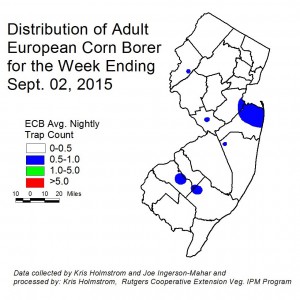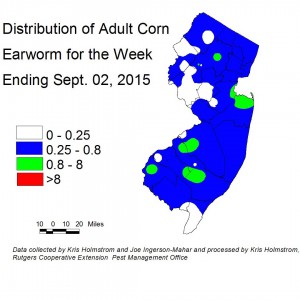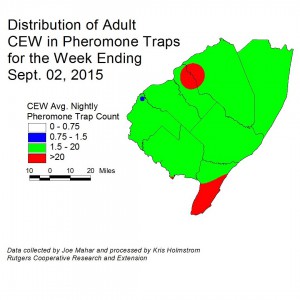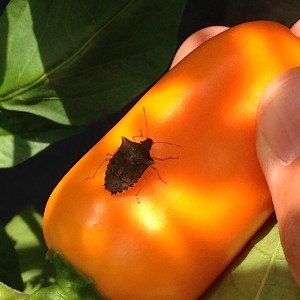Sweet Corn
The second European corn borer (ECB) generation continues to be weak. Catches are limited to scattered pockets registering more than one moth per week (see ECB map).
As always, consider treating when the number of infested plants in a 50 plant sample exceeds 12%. Any planting remaining at or above threshold as it proceeds to full tassel should be treated, as this is the last stage at which ECB larvae will be exposed and vulnerable to insecticidal sprays.
See the 2015 Commercial Vegetable Recommendations Guide for insecticide choices.
| The highest nightly ECB catches for the previous week are as follows: | ||
| Allentown 1 | Elm 1 | Matawan 1 |
| Cinnaminson 1 | Folsom 1 | New Egypt 1 |
| Crosswicks 1 | Georgetown 1 | Old Bridge 1 |
| Downer 1 | Hillsborough 1 | Woodstown 1 |
Corn earworm moth (CEW) activity has tapered down over the past week, with lower but regular catches throughout the state (see CEW Map). Dry weather is expected to dominate, with nothing in the near term forecast to indicate any weather-assisted movement of moths to our area. As always, we will monitor our populations and report immediately should such an event occur.
| The highest nightly CEW blacklight trap catches for the previous week are as follows: | ||
| Folsom 2 | Medford 1 | Phillipsburg 1 |
| Matawan 2 | Morristown 1 | Springdale 1 |
| Denville 1 | Oldwick 1 | Tabernacle 1 |
| East Vineland 1 | Pedricktown 1 | Woodstown 1 |
CEW moth catches in the limited CEW pheromone trap network in the southern counties have also decreased over the past week, with high catches remaining in Cape May and parts of Camden County. Overall activity is fairly consistent throughout the south, resulting in a broad area where a 4-day silk spray schedule (blue area) is recommended (see CEW blacklight map). The somewhat more conservative scale of the pheromone map indicates a 3-day schedule (green areas) in much of south Jersey. 3-day schedules are warranted throughout southern NJ at this time.
| The highest nightly CEW pheromone trap catches for the previous week are as follows: | ||
| Green Creek 49 | Beckett 7 | |
| Springdale 20 | Woodstown 7 | |
| East Vineland 15 | Elm 2 | |
For silking sweet corn, the following spray schedules are warranted.
Silking Spray Schedules*:
South – 3 days
Central – 3-4 days
North – 4 days
Fall armyworm re-infestation rates are very high at this time.
This pest can be devastating to small corn plants. Fields down to seedling stage should be scouted weekly for signs of infestation. FAW do not respond well to pyrethroid insecticides. The most useful products are those in the IRAC group 28 class (Coragen, Exirel, Belt) or the IRAC group 5 class (Radiant, Entrust), or combination products including these classes. See the 2015 Commercial Vegetable Recommendations Guide for insecticides effective against FAW.
Tomatoes
Late blight has again been reported from central Morris County. With longer dew periods occurring now, conditions may become favorable for this disease (at least overnight) as fall approaches. All tomato growers should be protecting their late crops against this disease. Growers with early tomato plantings that are no longer producing a viable crop (and which are no longer being treated with fungicides) should consider eliminating these plantings as a potential inoculum source. This may be done by physically removing plants or applying a chemical desiccant to the foliage.
Peppers
Recently, IPM scouts have discovered native brown stinkbugs (see photo) in pepper plantings in low, but increasing numbers. These bugs feed directly on fruit, resulting in unsightly blemishes. If this injury is found to be increasing in harvests, a treatment may be warranted. In general, broad spectrum insecticides are necessary to manage stinkbugs. Use of these materials may result in aphid outbreaks.
See the 2015 Commercial Vegetable Recommendations Guide for insecticides effective against stinkbugs.
Pepper Weevil Report
The trend continues – no weevils trapped in the past week and still no known infested fields.
Brown Marmorated Stink Bug (BMSB)
BMSB numbers remained very low in NJ blacklight traps this past week. These catches are too low to create a map. As yet, no fruit injury has been discovered in scouted pepper plantings.
Pumpkins and Winter Squash
Cucurbit downy mildew (CDM) is active on many cucurbit crops at this time. The intensity of infections varies by crop and location, with fields that retain leaf wetness for longer periods more heavily infected.
For more information on the regional presence of DM as well as comprehensive, weekly forecasts, see the following website: http://cdm.ipmpipe.org/ Growers should consider applying both protectant and systemic fungicides to all cucurbit crops at this time, to limit loss from this disease as well as powdery mildew.





